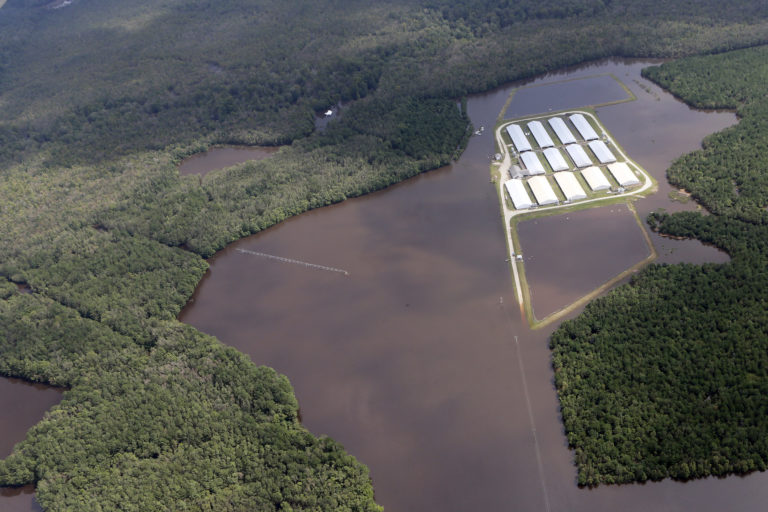Hog and Poultry Waste Threat in N.C. Has Gotten Worse Since Hurricane Florence
By: Waterkeeper Alliance

North Carolina’s industrial meat operations pose a greater environmental threat today than they did when Hurricane Florence hit the state in 2018. And the threat is worsening as global warming increases the intensity and severity of tropical storms and hurricanes.
The state’s poultry industry has grown unchecked, with no permitting requirement, and no prohibition on building in the state’s floodplain. The 538 million chickens and turkeys raised in North Carolina each year produce 5 million tons of waste.
Poultry litter is trucked to cropland, where it is spread as fertilizer. State rules allow poultry litter to be spread until it starts raining, even if there are National Weather Service storm warnings or watches.
The state hasn’t bought out any industrial hog operations since Hurricane Florence. The industry, which raises 8.7 million hogs in North Carolina each year, stores its waste in open pits. Each of North Carolina’s 3,500 open swine pits holds approximately 3.1 million gallons of waste.
The pits were built to last 10- to 20-years; most are now well over that age. A pit failed in June, dumping 3 million gallons of hog waste into a nearby creek, after a two-inch rainfall.
After being stored in open pits, hog waste is sprayed on nearby crop land. Permits governing these operations were amended in 2019 to triple the duration of permissible waste spraying after a storm-related watch or warning.
An overview of North Carolina’s waste threat:
- There are 43 swine facilities within the state’s 500-year floodplain and 32 within the state’s 100-year flood plain, according to data from the Environmental Working Group
- There are 74 poultry facilities within the 500-year floodplain and 41 within the 100-year flood plain, according to data from the Environmental Working Group.
- Hurricane Florence killed 5,500 of the state’s swine.
- About 4.1 million chickens or turkeys drowned or starved after Hurricane Florence. North Carolina spent $11 million composting dead birds or sending them to landfills.
- The location of these operations is an environmental justice issue. Communities surrounding industrial hog operations are disproportionately comprised of Blacks, Latinos, and American Indians. For instance, the three counties with the highest poultry growth in the state are predominantly Black, American Indian, and Latino. The single county with the highest poultry growth also has the state’s highest proportion of American Indians.
- The state bought out 42 factory swine operations in the 100-year floodplain after Hurricane Floyd. It bought out three operations following Hurricane Matthew. It hasn’t bought out any swine operations since Hurricane Florence.
- 91 swine operations, 125 swine waste pits, and 125 poultry operations were located in areas that flooded after both Hurricane Matthew and Hurricane Florence
“A cesspool failed in June, dumping more than 3 million gallons of hog waste into our waters,” said Kemp Burdette, Cape Fear Riverkeeper. “The cesspool failed following just two inches of rain—just two inches. These cesspools don’t belong in the path of stronger and more frequent hurricanes.”
“The massive growth of poultry operations in the Lumber River Watershed over the last two years has been devastating,” said Jefferson Currie II, the Lumber Riverkeeper and a member of the Lumbee Tribe of North Carolina, most of whom live in Robeson County. “All this is made worse by the fact that many of these concentrated animal feeding operations are in floodplains, putting vulnerable Native communities at even greater risk. The state knows about the risk these operations pose to the health of the Lumber River Watershed and local communities; yet it continues to allow new poultry operations to open in an area that we all know floods regularly.”
“We’ve seen increasingly frequent and severe storms,” said Will Hendrick, senior attorney at Waterkeeper Alliance. “Yet our leaders, ignoring recent history and scientific projections, weaken existing protections and reject calls for technological solutions.”
**Image: CAFO flooded during Hurricane Florence, September 17, 2018; Photo by Rick Dove, Waterkeeper Alliance